




Archive for the 'Farm Life' Category
Oct
12
There isn’t a lot to accomplish around the farm during the long months of Winter, except to keep the home warm and the water thawed for the chickens. When it is warm enough to feel my fingers I’ll work in the shop and possibly make progress on an antique tractor, repair equipment or maybe fabricate a new piece needed to make life easier while playing in the dirt.
Most of my time is spent on my artistic outlet(s), the main pursuit being the recreation of 18th century long rifles. I’ve always been artistic and I’ve always enjoyed working with wood. I also enjoy fine firearms and craftsmanship. Thus I took on this “hobby” of recreating period muzzleloaders 5 years ago. Prior to this I’ve mainly built plain Jane 700 Remingtons.
To date I’ve completed 3 rifles of various flavors and I am about to begin on my 4th. I am far from an expert but I am accomplished enough to achieve a good result with a roughly shaped stock and rough cast hardware. By no means can I consider myself a custom gun maker in this field, not yet anyway.
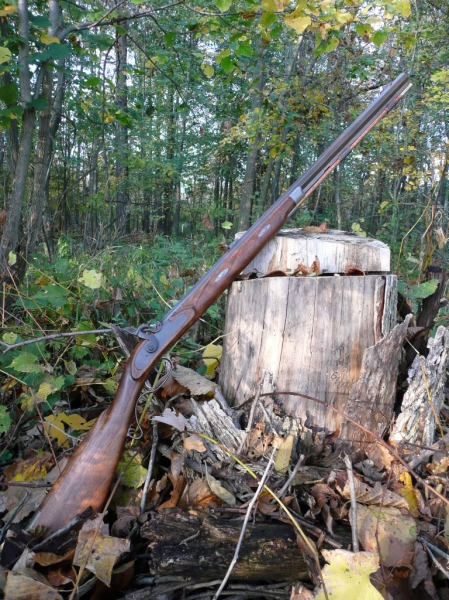 My first project was a rather simplistic Lyman Great Plains percussion rifle. This rifle was 50 Caliber and a straight barrel of 34″ length. A heavy gun as plains rifles generally were. A very generic 19th century rifle of the type that would have been found post 1830 West of the Mississippi. These are a decent “kit” for a beginner and require minimal tools to complete. The stock comes shaped and 95+% inlet. Lately it has been seen that some of the inletting is actually too large or out of position, something to be aware of if you purchase one of these kits. A working knowledge of wood and metal working / shaping / etc is beneficial to achieve a good result but a novice can accomplish this kit with some patience and thought before doing. While not a custom or even semi-custom gun it is a straight forward project that will yield a fine firearm. They are accurate and with a bit of work to the lock internals and the double set triggers they will rival some of the best aftermarket components. I sold this rifle a couple of years back as I wanted to venture into the realm of Colonial period (1750 – 1790) flintlocks.
My first project was a rather simplistic Lyman Great Plains percussion rifle. This rifle was 50 Caliber and a straight barrel of 34″ length. A heavy gun as plains rifles generally were. A very generic 19th century rifle of the type that would have been found post 1830 West of the Mississippi. These are a decent “kit” for a beginner and require minimal tools to complete. The stock comes shaped and 95+% inlet. Lately it has been seen that some of the inletting is actually too large or out of position, something to be aware of if you purchase one of these kits. A working knowledge of wood and metal working / shaping / etc is beneficial to achieve a good result but a novice can accomplish this kit with some patience and thought before doing. While not a custom or even semi-custom gun it is a straight forward project that will yield a fine firearm. They are accurate and with a bit of work to the lock internals and the double set triggers they will rival some of the best aftermarket components. I sold this rifle a couple of years back as I wanted to venture into the realm of Colonial period (1750 – 1790) flintlocks.
 My first flintlock was a mish-mosh of components. A pre-carved stock of what was called a Pre-Revolutionary Kentucky pattern from Pecatonica. It has no real “school” in which it fits but with an English style lock and the butt profile it’d probably pass as a Maryland or Virginia built rifle of the 1770’s or 1780’s. The stock is a nice piece of Red Maple with good curl that I requested only as roughly shaped with a barrel and ramrod inlet. It holds a 42″ tapered and flared Green Mountain barrel in 50 caliber. The lock is a Jim Chambers Round Faced English with a “waterproof” pan. The trigger is a simple pinned trigger. The hardware is a mixture of elements from Reading to Lancaster to Virginia. I finished the wood in a series of aniline dyes and sealed it with tung oil. Steel components were heavily cold blued and rubbed
My first flintlock was a mish-mosh of components. A pre-carved stock of what was called a Pre-Revolutionary Kentucky pattern from Pecatonica. It has no real “school” in which it fits but with an English style lock and the butt profile it’d probably pass as a Maryland or Virginia built rifle of the 1770’s or 1780’s. The stock is a nice piece of Red Maple with good curl that I requested only as roughly shaped with a barrel and ramrod inlet. It holds a 42″ tapered and flared Green Mountain barrel in 50 caliber. The lock is a Jim Chambers Round Faced English with a “waterproof” pan. The trigger is a simple pinned trigger. The hardware is a mixture of elements from Reading to Lancaster to Virginia. I finished the wood in a series of aniline dyes and sealed it with tung oil. Steel components were heavily cold blued and rubbed  back with oiled 4/0 steel wool to a gray patina. Stock decoration is simple and you can easily tell it was my first attempt at relief and incised carving with hand tools as the relief carving lacks shape and depth in execution. It is an accurate fine shooting weapon but the LOP is a bit long for my short stature. This rifle is currently for sale and you may contact me to inquire about more photos, details or pricing.
back with oiled 4/0 steel wool to a gray patina. Stock decoration is simple and you can easily tell it was my first attempt at relief and incised carving with hand tools as the relief carving lacks shape and depth in execution. It is an accurate fine shooting weapon but the LOP is a bit long for my short stature. This rifle is currently for sale and you may contact me to inquire about more photos, details or pricing.
My latest completed rifle began life as a Jim Chambers Isaac Haines stock and accompanying hardware. This stock comes 95% inlet and includes hardware that is easily passed off as Dickert, Albrecht, etc with some modification. I chose a standard 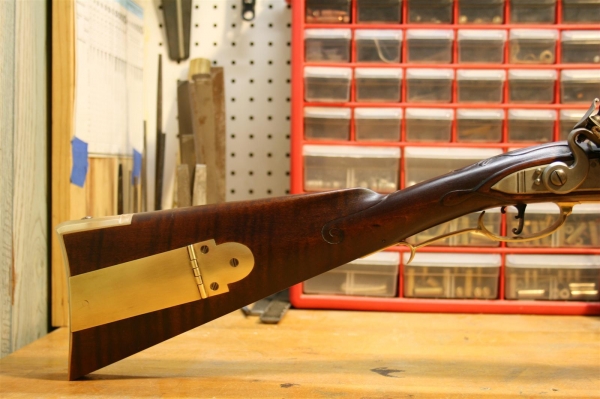 “grade” of stock so that it has some curl but not overly embellished. I like understated simplicity. The barrel is a 38″ Rice C profile tapered and flared in 54 caliber and was acquired elsewhere prior to my decision of the stock. The lock, supplied with the stock is a Jim Chambers Golden Age Germanic. I wanted to build a personal rifle in 54 with a shorter barrel because it is easier for me to load. At 5′ 7″ a 42″ or longer barrel makes it awkward for me to load as it puts the muzzle at face level. I had had good success with the Pecatonica stock that had inletting omitted but Chambers pieces come highly recommended so I took a chance. I was only mildlydisappointed that there wasn’t a “ton” of extra wood which allows for more creativity in shaping. I also am now blatantely sure that I don’t like all of the components pre-inlet because I am stuck with
“grade” of stock so that it has some curl but not overly embellished. I like understated simplicity. The barrel is a 38″ Rice C profile tapered and flared in 54 caliber and was acquired elsewhere prior to my decision of the stock. The lock, supplied with the stock is a Jim Chambers Golden Age Germanic. I wanted to build a personal rifle in 54 with a shorter barrel because it is easier for me to load. At 5′ 7″ a 42″ or longer barrel makes it awkward for me to load as it puts the muzzle at face level. I had had good success with the Pecatonica stock that had inletting omitted but Chambers pieces come highly recommended so I took a chance. I was only mildlydisappointed that there wasn’t a “ton” of extra wood which allows for more creativity in shaping. I also am now blatantely sure that I don’t like all of the components pre-inlet because I am stuck with 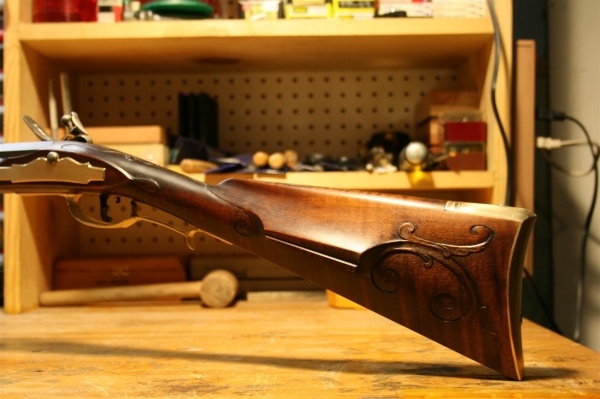 wherever the stock maker decides to put them. The execution of this piece is much more advanced than my previous attempt and my abilities with design, execution and vision have improved greatly. The carving is a reflection of an early 1770’s Albrecht rifle found in RCA 1. It again uses a simple pinned trigger and I have substituted sheet brass thimbles and added a simple sheet brass patch box. This rifle is finished with a traditional Linseed Oil & Pine Rosin finish which is “in” the wood rather than on. Currently there are 4 coats with at least another 4 to go. This provides a traditional, hand rubbed, durable, satin “antique” finish. My next educational venture is to begin to develop my engraving skills.
wherever the stock maker decides to put them. The execution of this piece is much more advanced than my previous attempt and my abilities with design, execution and vision have improved greatly. The carving is a reflection of an early 1770’s Albrecht rifle found in RCA 1. It again uses a simple pinned trigger and I have substituted sheet brass thimbles and added a simple sheet brass patch box. This rifle is finished with a traditional Linseed Oil & Pine Rosin finish which is “in” the wood rather than on. Currently there are 4 coats with at least another 4 to go. This provides a traditional, hand rubbed, durable, satin “antique” finish. My next educational venture is to begin to develop my engraving skills.
On my bench now is my first “paying” project. This is an old Sharon Trade Rifle kit (untouched) that an acquaintance purchased via auction and asked me to put together after seeing my completed Lyman as 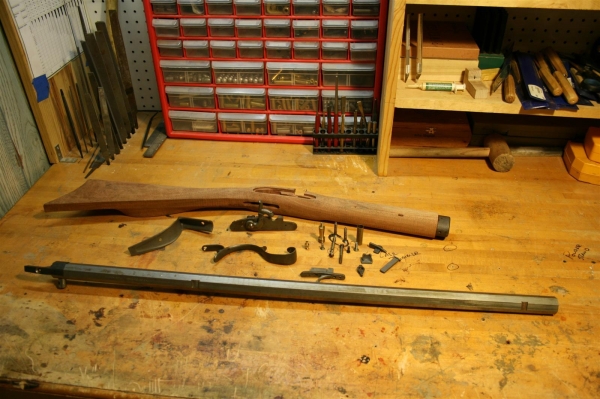 well as my Virginia flintlock. I have not begun on it physically but I have been investigating period guns and their attributes in order to hopefully make this gun look like it fits in the 1840’s rather than like the modern day Hawken kits you see from Thompson Center or Cabelas. I hope to have it complete sometime in January.
well as my Virginia flintlock. I have not begun on it physically but I have been investigating period guns and their attributes in order to hopefully make this gun look like it fits in the 1840’s rather than like the modern day Hawken kits you see from Thompson Center or Cabelas. I hope to have it complete sometime in January.
For #5 I have been studying New England fowling pieces (shotguns). Something I can use both for shot as well as patched ball, most likely a 20 bore (62 Caliber). Many of my ancestors immigrated to New England between the time the Mayflower arrived and the early part of the 18th Century. They eventually migrated from New England to Eastern and Northern Pennsylvania before and immediately after the Revolutionary War. Therefore I feel it fitting that this would have likely been the type of firearm in their possession. It’s a way for me to honor their memory, sacrifice and suffering that in documented cases they endured and sometimes perished from. I am proud of my lineage and my ancestor’s perseverance.
Oct
5
Weather has begun to cool and we’ve had at least two minor frost events in the last week. This means that everything except cole crops have stopped growing. Good. We are burnt out due to produce overload this year.
Pumpkins went in the ground a bit late and therefore are slightly behind in ripening. Still some green to be seen through-out the patch. The “plan” is to begin setting pumpkins, corn stalks and gourds out this weekend. The weather is supposed to be warm and sunny all week and that should aid the ripening process.
I’ve spent the past two evenings hanging tobacco in the green house also. All of the Virginia varieties have had their leaves removed from the stalks and tied in bunches and hung.
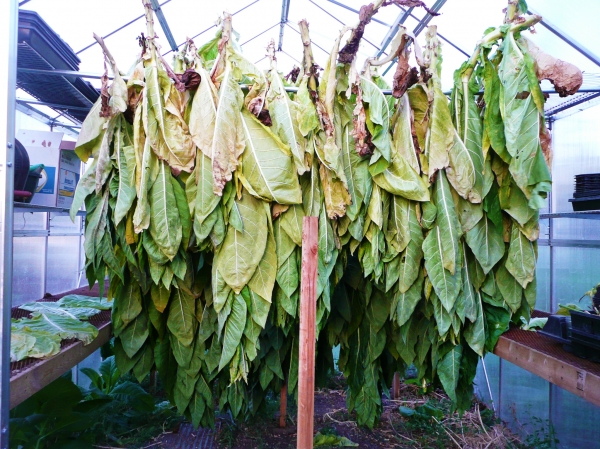
About half of the Burley has received the same treatment since space is at a premium. This is an experiment more than anything and I doubt I’ll have any dried down in time to sell this fall. I most likely will leave it hang all Winter and offer leaves for sale in the Spring with seedlings.
So aside from cleaning up the fields, pulling plastic, plowing and planting a cover crop we are quickly wrapping up 2011. The Winter will be a welcome break from the hectic schedule we seem to maintain during the “season”. It will also allow me to focus on a few of my other hobbies.
Aug
31
2011 has been a significant learning experience. With expansion and variety come new challenges and time demands. I am an engineer by profession and that consumes, easily 50 – 60 hours of my week. Trying to plant, manage, weed, harvest and control bugs and disease in 25 different products in the remaining hours of my week has proven nearly impossible. Especially without the aid of modern chemistry. I find that I have no time to work in the shop or enjoy any form of recreation from May through October. It has gotten old and the return on investment just isn’t there.
Therefore for 2012 we’ll be concentrating on what we know and do well. This mostly means concentrating on a few products in larger quantities and elimination of our CSA program.
I have concluded that our season can be broken down into 3 main time periods. May – June, July – Mid September and Mid September – End of October.
May and June in Michigan aren’t known for fruit bearing seasons except for greenhouse grown products and strawberries. Maybe a few cole crops such as peas, early broccoli and kohlrabi. Most produce seedlings and seeds aren’t sown until mid – 3rd week in May here in zone 5 due to frost uncertainties. In 2012 we’ll be concentrating on seedlings for market as well as our strawberries which consist of a few hundred mother plants put in this past spring. We’ve been considering a 1/2 acre addition of strawberries, mainly June bearing. Possibly offering a limited u-pick opportunity as well as taking fruit to market.
Our main season, July (really mid month) – Mid September would see us concentrating on providing sweet corn, tomatoes and a variety of melons (cantaloupe, watermelon, hybrid melons). I have been considering a quantity of strictly canning / processing type tomatoes but there doesn’t seem to be the market for any quantity. I’ve decided any watermelon I grow will be a triploid (seedless) variety, people have become accustomed to seedless.
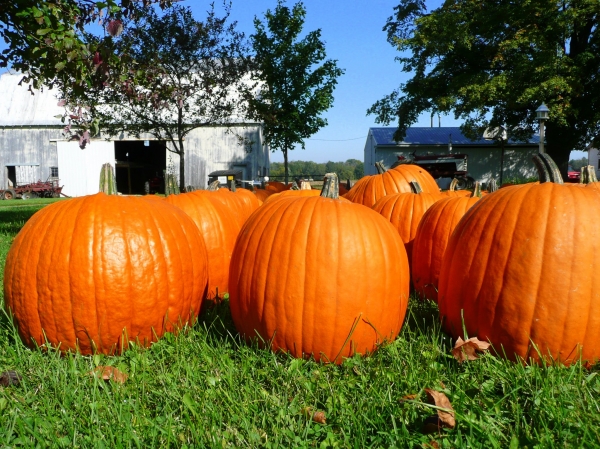 Mid – September through October of course is fall ornamental season. Winter squash, corn stalks, indian corn, pumpkins and gourds. Mostly offered roadside and maybe a u-pick pumpkin patch for the kids.
Mid – September through October of course is fall ornamental season. Winter squash, corn stalks, indian corn, pumpkins and gourds. Mostly offered roadside and maybe a u-pick pumpkin patch for the kids.
Now we just have to see what varieties do best in various trials and get busy prepping. Everything but our 4 rows of strawberries will be plowed this fall and annual rye planted. The rye will again be turned under in the spring ahead of planting and this should alleviate some of our fertilizer requirements.
We are actually excited about streamlining and the possibility of once again having the ability to enjoy summer while still offering items that customers flock to us for.
Happy birthday Dad…
Aug
24
2011 has had it’s ups and downs, it’s positives and it’s negatives. Some items have done well and others have struggled. Bug and weed pressure have been very high and with that various diseases.
Sweet corn has probably suffered the worst. With the cool spring it was very difficult / impossible to keep ahead of the grass in row with cultivation. I’ve been on a “no pesticides” kick and hence my only way to control most weeds is to choke them out, cover the ground or manual cultivation. This year has been a disaster. There are not enough hours in the day to get done what needs to be done on this scale while working a full time day job. If the Spring was not difficult enough, the hot dry July really took it’s toll. Poor pollination and stunted ears, compounded by weed pressure resulted in poor yields. Deer and raccoon didn’t make it any less difficult. The deer have a tendency to enjoy the tassel of the corn and without the tassel pollination is difficult. The first replication (1/4 acre in size) was a total loss. The deer had eaten most of the tassels and what did make an ear the raccoon finished off for dessert. I harvested 9 good ears and then mowed down $1000 worth of corn without selling a single ear. Luckily the corn that matured toward the end of the month and beginning of August received some moisture and cooler weather and made some decent product. 13 raccoon were removed and the soybeans matured and animal damage diminished significantly. As of today we have one replication of sweet corn remaining and I should have 2 weeks worth of harvest out of it beginning this Friday.
This last replication was a bit of an “experiment” for me. I have an area, about 1/4 acre in size where I traditionally have rotated melons. This year it was bare and the grasses overtook it and I left it fallow until almost the middle of June. I had plenty of seed left so I loaded the sprayer with glyphosate and burnt it down. After a week I added weight to the row units of the planter and pretty much no-tilled seed into the area. The 400 Cyclo IS NOT a no-til planter. It worked ok but we won’t make a habit of it… We did the same for pumpkins and that was a disaster. When the corn was about 18 inches I had plenty of broadleaf pressure so I applied 2,4-D by hand between rows with the back-pack sprayer. What has resulted is a good corn stand with small grasses about 6 inches high.
To go one step further, in August I decided it was time to get my applicator’s license so that I had more options should I need them. After cramming for a week and an 89% on the exam I am now certified. The beginning of August I had planted what was left of my sweet corn seed, about 1 lb worth, where I had disced my first replication under in Mid July. Last night I applied Atrazine + Dual II Magnum to see how well it’ll control the grass and small broad leaves. The corn is about 5 – 6″ tall and planted at a 30,000 population. About 12 rows worth. If we can maintain some temperature and water and avoid a frost it MAY make corn sometime in October. Good luck to that. At least we are being pro-active in our weed management program.
Cucurbits (melons, cucumber, watermelon, squash) have been another problem. Squash bugs have been tough on them and anthracnose has pretty much done the cucumber in and decimated the first watermelon crop as well as cantaloupe. Hopefully some Sulfur and Copper will arrest it on what is left. The squash bugs are tough buggers to kill and over the counter insecticides don’t tend to work well so they’ll just have to continue to eat winter squash. Hopefully the plants can hang on. I have a 2nd planting of melons coming on and I hope that they fruit well.
The one shining light on the season has been the tomatoes. Boy do we have tomatoes. Disease pressure has been low and aside from having to pick a few horn worms off only the grass hoppers have been an issue. We’re harvesting bushel after bushel a this point, more than we can seem to sell. We’ll be doing quite a bit of canning in the coming weeks. The Sunsugars have been particularly popular as they are sweet like candy. I always tell folks that I don’t care for tomatoes. It is a texture and taste thing, but the Sunsugars – I’ll eat them like candy all day long. The Charger that we grew has also performed admirably. A nice 6 oz tomato with a good set, no disease, a healthy plant and no cracking.
One thing I have learned from this season is that I cannot manage this many crops with this many issues, by myself in the amount of time I am left with after a full time day job. It is time to change course and streamline. Not downsizing, chances are we’ll expand acreage for 2012, but I need to concentrate on a limited number of items that I can grow and sell in large quantites. Items such as sweet corn, melons, tomatoes and pumpkins. We’ve even been discussing strawberries and raspberries for a small U-pick operation. I am looking for a niche to exploit. Maybe the tobacco leaves will be the fall hit.
Stay tuned for 2012 planning.
Jun
15
Things are progressing nicely and Mother Nature has been fairly kind to us thus far. Everything except for a few tobacco plants are in the ground and thriving. Many plants are flowering and some are bearing fruit. Most of the melons, and vine plants are running and the bees seem to be content. We have been harvesting some Swiss Chard as well as White Kohlrabi for a couple of weeks now. Soon zucchini and cucumber should be on the list and the cabbage is heading nicely.
We had a minor setback with some of our root vegetables due to the cool spring weather and slow germination. Cool weather never seems to bother weeds and they managed to overtake the beets and other root crops. I ended up disking them under and replanting last weekend. As of last evening most have begun to poke through. Unfortunately this leaves us with a slight hole for variety as we probably won’t see beets for market until August now.
Weeds have been a slight issue in the sweet corn, potatoes, onions and strawberries. Not so much broadleaf weeds but grasses. I spent a couple of evenings this week thus far pulling the tall grass from the potatoes and then hilled them with the Super A which covered small weeds. I need to do the same to the onions. I also cultivated sweet corn for the 2nd time last night and hilled the larger plants. There is still a lot of grass in the corn and the only way to get it out is to be more aggressive with the hilling or find someone who will part with a couple of ounces of Laudis. I have used no herbicides except for pumpkin cover burn down and prefer to keep it that way but if I can’t get ahead of the grass I may be forced to resort to drastic measures.
Bug pressure has been pretty non-existent thus far but Colorado Potato Bugs have begun to appear and are munching on the potato leaves. Not much we can do about it this year but hopefully the tobacco will yield a usable organic pesticide next year. We are awaiting the dreaded mass of cucumber beetle that we always seem to be plagued with. European corn borer pressure is forecast to be fairly heavy this year. We’ll see. No one seems to like worms in their corn.
The cover between the plastic (oats, yellow peas & hairy vetch) is working fairly well. I have mowed it twice now. The clippings are blown onto the plastic to form a covering mulch which will protect the plastic from the sun’s UV which causes the plastic to become weak and brittle. 2 weeks ago during the hot spell we had I laid and hooked up the header pipe for the drip irrigation and have run it twice to date. I actually let it run all night last night. I have found a couple of breeches in the T-tape which I need to fix, lest I should flood some poor seedlings in the low ground.
With any luck we will be able to start our CSA program by July 1st. The cool Spring has set us back slightly but we are working to prevail. We will be extending the CSA program for as long as possible into fall, up to and probably past first frost into the pumpkin season.
May
3
We had plenty of April showers, now lets hope Mother Nature blesses us with May flowers and warm weather. The extended forecast appears promising but I take that for what it is… Last weekend was beautiful and we managed to accomplish quite a few chores around the farm. With the warm weather has come a significant increase in soil temperature and every row crop farmer around here is in the field planting corn. Looking at the extended forecast I decided to take a chance too…
The 560 and I did a little tillage yesterday evening and then we put the 400 Cyclo to the test planting sweet corn. Yes I took a gamble and have my fingers crossed that the extended forecast is as warm as it predicts and warms the soil enough to germinate my $20 / lb ($430 / 80K seed bag) sweet corn seed. So… May 2, 2011 the first sweet corn went in the ground. In a week or two we’ll be able to gauge how well the Cyclo performed. I hope that I don’t need to thin the stand nearly as much as I did last year. I have cut back on population for 2011 planting at a rate of 19500 / acre which results in a plant spacing of about 8 3/8 inches with row spacing at 38 inches. We’re putting down 180 lbs of 11-52-0 starter / acre off of the planter. With the dairy manure incorporated as well as broadcasting 200 lbs of 46-0-0 (urea) we should have plenty of nutrients to grow some good corn. Stay tuned…
Also with the good weather we had an opportunity to get some of the cool weather resistant crops in the ground this past weekend. By seed we planted radish, beets (red as well as golden) and turnip. I also had an opportunity to put the trans-planter to use and used it to cut a furrow to place potatoes and onions. By doing this I can get the potatoes below ground and then hill as they grow upward. By placing on top of the ground and hilling you end up with some tubers being exposed after a heavy rain. We planted both Yukon as well as Pontiac potatoes, as we did last year and the onion sets are regular old yellow sweet onions. We’ll follow up in a month with another round of each so that we have a season long supply.
 We are really looking forward to this month and being able to get all of our seedlings in the ground. The greenhouse is performing extremely well and plants are growing beyond precedent. Tomatoes, peppers, melons, cukes, zukes, squash, cool weather crops and tobacco seedlings all are flourishing and we are filled to capacity. Some of these will be going to market with us to sell and I am looking forward to the first market of the year which will be May 14th. Once I get some of these seedlings cleared out I can start my second replication of melons. Later this summer I will start more cool crops such as cabbage, cauliflower and broccoli.
We are really looking forward to this month and being able to get all of our seedlings in the ground. The greenhouse is performing extremely well and plants are growing beyond precedent. Tomatoes, peppers, melons, cukes, zukes, squash, cool weather crops and tobacco seedlings all are flourishing and we are filled to capacity. Some of these will be going to market with us to sell and I am looking forward to the first market of the year which will be May 14th. Once I get some of these seedlings cleared out I can start my second replication of melons. Later this summer I will start more cool crops such as cabbage, cauliflower and broccoli.
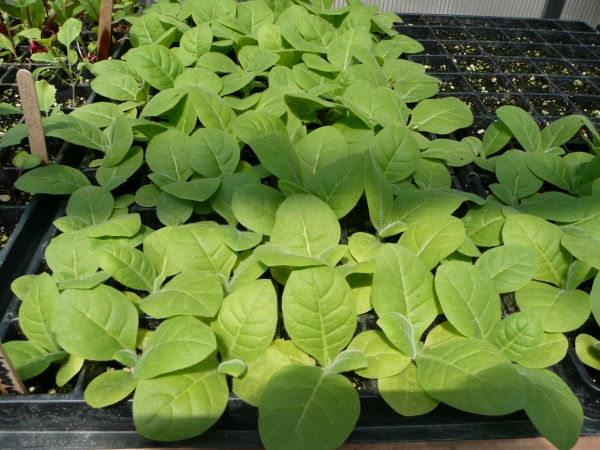 One of the new items we are growing this year is tobacco. Yes tobacco, in Michigan. Tobacco is a nightshade family of plant, just like tomatoes and requires a very similar growing environment and season. With the price of tobacco products and the independent nature of people in and around our community I felt there was an opportunity to add another profitable product to our operation. We’ll be selling seedlings at market this month and will plant some of each variety to grow. By growing a few of each variety I will be able to bag the flowers and harvest seed and in the fall we can provide whole leaves at market for people to cure and ferment at home and turn into a usable product themselves. We may also experiment with manufacturing a nicotine based “organic” pesticide. This is a very exciting venture for us and thus far is going well. We have 320 or so plants in 4 varieties about ready to go to market with another 1000 or more that need to be up potted to individual cells. As the season progresses look for updates on our progress.
One of the new items we are growing this year is tobacco. Yes tobacco, in Michigan. Tobacco is a nightshade family of plant, just like tomatoes and requires a very similar growing environment and season. With the price of tobacco products and the independent nature of people in and around our community I felt there was an opportunity to add another profitable product to our operation. We’ll be selling seedlings at market this month and will plant some of each variety to grow. By growing a few of each variety I will be able to bag the flowers and harvest seed and in the fall we can provide whole leaves at market for people to cure and ferment at home and turn into a usable product themselves. We may also experiment with manufacturing a nicotine based “organic” pesticide. This is a very exciting venture for us and thus far is going well. We have 320 or so plants in 4 varieties about ready to go to market with another 1000 or more that need to be up potted to individual cells. As the season progresses look for updates on our progress.
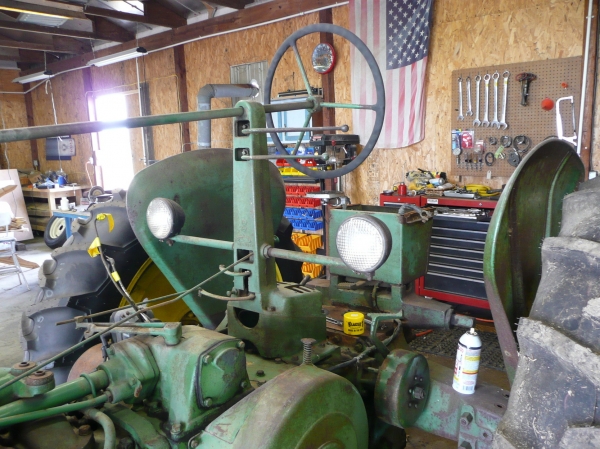 I have also been diligently working in the shop. The shop is clean and organized pretty well and the John Deere B has been pulled out of her hole and I have it nearly split in half for gasket repair as well as a few other nagging issues to resolve. I have discovered that at some point someone must have worked on the transmission and did not achieve enough torque on the fasteners. They are all fairly loose and this resulted in components shifting against one another in turn effectively wearing away the gasket. Time has also taken it’s toll on wiring and I will be building a new harness to replace the original that has deteriorated and left many bare wires to short. I would like to finish this project before July. It needs to be finished as I have a couple of repairs to do once it is, one of which I think is going to be replacing the clutch and pressure plate in the 560.
I have also been diligently working in the shop. The shop is clean and organized pretty well and the John Deere B has been pulled out of her hole and I have it nearly split in half for gasket repair as well as a few other nagging issues to resolve. I have discovered that at some point someone must have worked on the transmission and did not achieve enough torque on the fasteners. They are all fairly loose and this resulted in components shifting against one another in turn effectively wearing away the gasket. Time has also taken it’s toll on wiring and I will be building a new harness to replace the original that has deteriorated and left many bare wires to short. I would like to finish this project before July. It needs to be finished as I have a couple of repairs to do once it is, one of which I think is going to be replacing the clutch and pressure plate in the 560.
Finally, in closing we still have a few CSA shares available. By selling CSA shares this allows us to have a good cash flow for operating expenses up front and it gives us an idea of how much we need to plant. We feel it is a win / win for both us as well as our customers. If you wish to tailor a CSA share to your specific needs please contact us and we’ll work to fulfill your needs.
Apr
26
2011 began well enough but has quickly begun to erode these past few weeks. We have been hampered by continuous rain and cold temperatures which have set us back at least a couple of weeks. We aren’t the only ones though. We have not seen a single row crop farmer anywhere near dirt with a planter. Temperatures for planting dent corn are just on the cusp of being warm enough yet the dirt has too much moisture. Nothing but rain in the forecast for the next week either. We plan to be at least 2 weeks behind this year on most warm weather vegetables such as tomatoes, melons and sweet corn, especially sweet corn.
If that isn’t enough, we lost my Uncle this past Saturday after a long illness. He went peacefully with a large portion of family, including myself, at his side. He was 66. He was my Father’s brother and as previously posted, we lost my Father to cancer just over 11 months ago. It has been a difficult pill to swallow. The funeral will be this Thursday and then the reality of dealing with the farm and 50 years worth of collecting that needs to be dismembered in a manner yet to be decided on. This photo is one of the last of my Father and Uncle taken together. This photo was at the completion of the 2009 Mackinac Bridge Crossing, just a month before my Father became noticeably ill.
On a high note we did manage to hill and mud in a hundred or so strawberry plants last week. Half are a Junebearing and half are an Everbearing. We probably won’t pick blossoms and that will allow us to have a harvest, though a reduced one. Going against the grain of most commercial strawberry growers. We’ve also been able to transplant cool weather crops such as kohlrabi, cauliflower and broccoli. Cabbage will be next as well as the 2nd round of the previously mentioned items.

The Greenhouse is also holding together well and it is full to capacity. So much so that I’ve added a second tier of shelving and filled it and have also transplanted a few tomatoes and some cauliflower in areas outside of the walk way. I will soon have to up pot a few thousand seedlings and at that point space is going to be VERY tight.
I’ve also begun to finish work on the John Deere B I wrote about last year. I feel very “melancholy” that I did not dedicate enough time to finish it before my Father passed and with ambition low I didn’t finish it before my Uncle’s passing. It will surely be sold by my Mother and Aunt but I feel it would be a shame to let the restoration components and paint my Father purchased for it go to waste or to be sold piece by piece. Hopefully, I can persuade my family to put this tractor back into the hands of the original owner’s Grandchildren, my second cousins. I believe in Karma.
I pray that this streak of luck soon turns to the better and that God will shine his mercy down upon us and our small operation. 2011 is going to be a very difficult year trying to balance work, farming and squaring away family business. Keep us in your prayers and thoughts.
Apr
5
How did April sneak upon us so quickly? Maybe it’s the cool, damp weather and sharp NE wind we’ve been experiencing for the past month and a half. Our “normal” mid March warming trend seems to have eluded us in 2011. None the less I now find myself under the gun with a laundry list of tasks to complete.
We finished the greenhouse, for all intensive purposes, last weekend. There are loose ends to take care of but they are not pressing. Items such as plastic and a layer of stone for the floor and bracing to add support to the roof. The roof supports can wait as they won’t be required until the snow begins to fall. The stone I could use because I don’t want to be walking in mud as I water seedlings. I did take time the other day to transplant some rhubarb and set out seed trays which I need to fill with a starter mix and get dampened. One of the laundry list items.

Speaking of seedlings… The basement has no more room for them. Hundreds upon hundreds of seedlings growing under fluorescent lighting everywhere. With temperatures remaining above freezing for the foreseeable future I’ll be moving some of the more hardy to the greenhouse in the next day or two. Items such as cabbage, kohlrabi, cauliflower and broccoli. The extended forecast looks promising, highs in the 60’s and low 70’s which means tomatoes, peppers, egg plant, etc can move to the greenhouse also. This weekend will probably see the starting of most of my cucurbits such as cucumber, cantaloupe, watermelon, squash, etc as we target a May 15th transplant date if the weather is acceptable. Nightly temperatures being the watch point as even high 30’s with a breeze can cause frost damage to delicate seedlings.
We also are in dire need of machinery prep. I have been working to re-organize and clean the shop which has undergone a deterioration of such over the past year. I’ve managed to clean and dispose of quite a few items that have been sitting on shelves collecting dust for a number of years. I’ve also found that I have quite a few Farmall parts that I have accumulated which could use a new home. I have a few more evenings to spend in the shop and it should once again be usable. Then I can move on to the important “stuff” such as laying plastic and drip tape and corn planter prep.
Yes the 400 Cyclo remains where I put it after bringing it home. I haven’t touched it. Though I did buy seed plates for our 2011 sweet corn seed for the 455 just in case the 400 doesn’t quite work out as I hope. I have plenty of time (relative) to get things in order as we can’t put sweet corn seed in the ground until I have 62F @ a couple of inches early in the morning (coldest part of the day). Any cooler and this Sh2 seed will sit there and rot. Even in the low 60’s it’ll take almost 2 weeks to germinate and with the cool spring thus far I do not foresee an early planting date as we experienced in 2010. I am keeping my fingers crossed though.

I also need to trial run my home built much layer and see what improvements it is going to require, if any. I have nearly a half mile of plastic and drip tape to lay and the sooner the better as the black plastic will really heat the ground beneath and will help to protect seedlings as well as make them root well. Before I can do this I need to get the disk in the ground and incorporate the manure spread on the fields. Once I have things fit well I need to broadcast my oat / pea cover mix both on my permanent bed area as well as my pumpkin field. If I can get this cover going early I should have good grown by Mid June and can get it rolled down and killed for pumpkins. The hope is to create a very thick straw mat which will hold moisture in and keep weeds at bay.
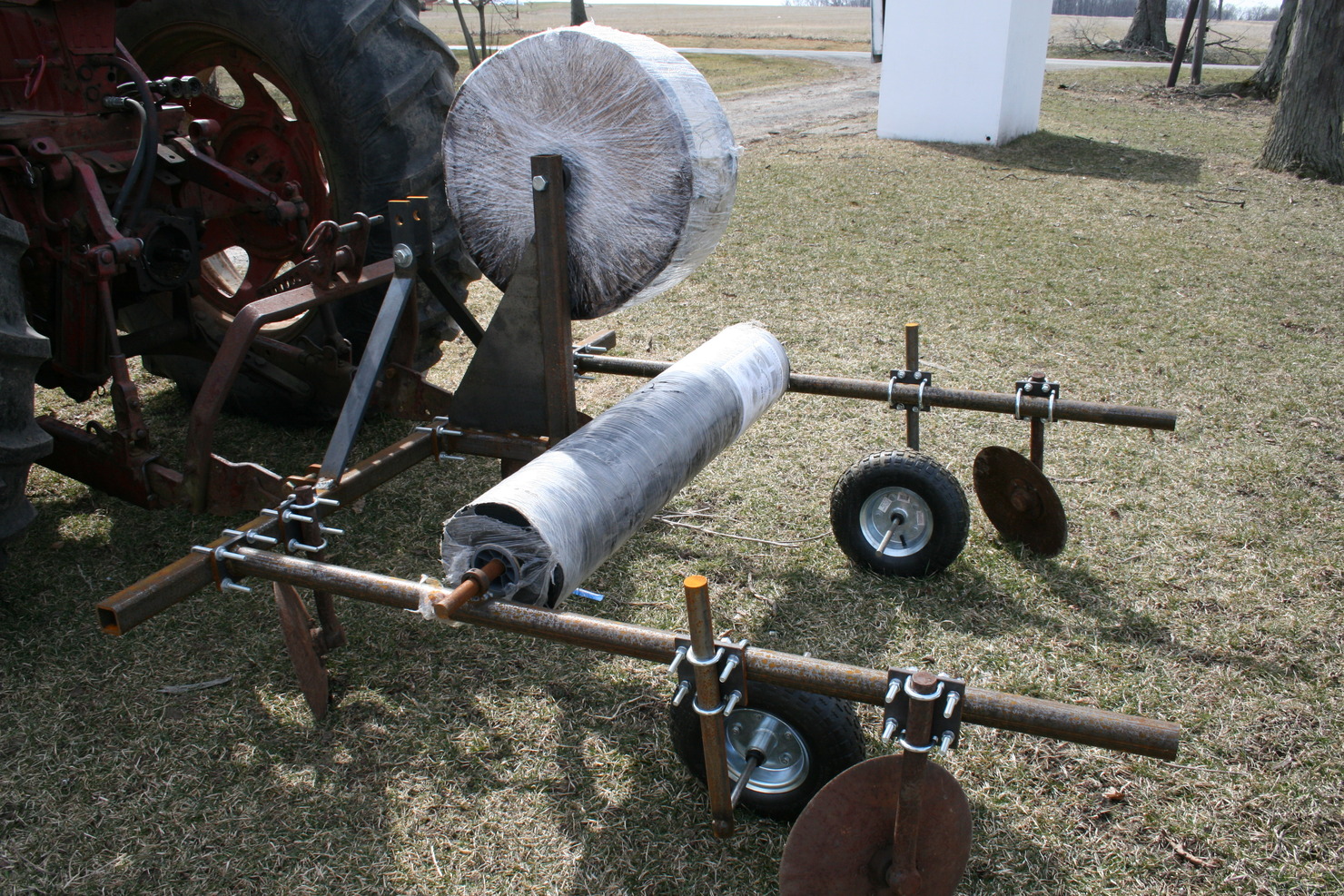
The peas and oats will be mixed with hairy vetch in the permanent bed area and then the plastic laid over it. This way we get a good cover stand between the plastic strips and I can mow it off in a couple of months and use the debris to cover the plastic and act as a sun shield as well as holding the weeds at bay. Next year we can come in and sew some clover for a good cover which will remain until we lift the plastic in a couple of years.
A lot of work to be completed in the coming weeks. In that mix I also need to get snap peas, potatoes, onions, strawberries and the rest of my cold weather tolerant crops in. Items such as cauliflower, broccoli and cabbage. Looking at the entire list I may have to seek out some temporary hired help to get it done. I know I am going to have to hire help as I cannot both drive the tractor and run the transplanter at the same time. The fun of expanding a business and trying to become more efficient.
Upon closing I urge you to visit our CSA PAGE if you are interested in participating in our Community Supported Agriculture (CSA) program. I have tried to compile a program that can meet the needs of many. We still have a few openings we would like to fill and welcome all interested parties. We also have an online CSA application form that you may print, fill out and return to us in person or by mail.
We look forward to continuing to serve existing customers as well as making new customers and friends for 2011. Until next time, pray for warm weather and fair skies.
Mar
30
Take a moment or two and browse the J.A.Root Farms photo gallery. It contains, literally, thousands of photographs of our projects, trips and day to day life around the farm.
J.A.Root Farms Photo Gallery Here…
Enjoy and check back often as we update continually.
Mar
30
Since my last entry I have made quite a bit of progress on the greenhouse. The framing is complete and I have added elements to increase it’s resistance to the wind and need to do a few more. I have now begun adding shelving which is tied, integrally, into the framework.
Taking cues I have seen elsewhere about improving the HFGH I have added a total of 5 lengths of 3/4 conduit. Two (2) have been added to the back wall, one to the front wall directly above the door track and 3 spanning from wall to wall at the gutters. All are affixed to wall studs with home-made T-nuts and the ends are tied into the corner posts and struts with #8 x 1″ self tapping screws. While I agree this helps stiffen the structure I feel it is far from adequate to secure the framework sufficiently under heavy wind loads. Movement of the structure will result in it’s demise.
To further aid in re-enforcing the structure we need to add some triangulation. This is already a part of the design in several areas. Each corner post has 2 rectangular tube gussets which cause triangulation in two planes. They are woefully insufficient and in and of themselves are too weak for such long columns. They will buckle and fail, especially at weakened points such as punched bolt holes, BTDT. IMO fore / aft movement is the greatest weakness in the structure at this time. More bracing needs to be added in planes perpendicular to the ground. Adding elements from the ridge to the conduit bracing running from sidewall to sidewall should make a difference also. I will provide examples of my solution when I complete the modifications.
I have made progress on the shelving also. Using 2 x 4 construction I have tied the first portion of the shelving to the wall and studs using, again, t-nuts which I have made myself from 10-24 x 2 carriage bolts. The heads have been ground to width, equally, from both sides via the belt sander. I will bring the shelving out 24 inches from the wall and support with legs which will rest on pavers. The object is to make one solid shelving unit in a U shaped configuration. I have left enough room to be able to add a second level of shelving if I so need it in the future. To finish this up I will use a few 55 gallon plastic drums as support for a central table. They will add some thermal mass to the whole deal.
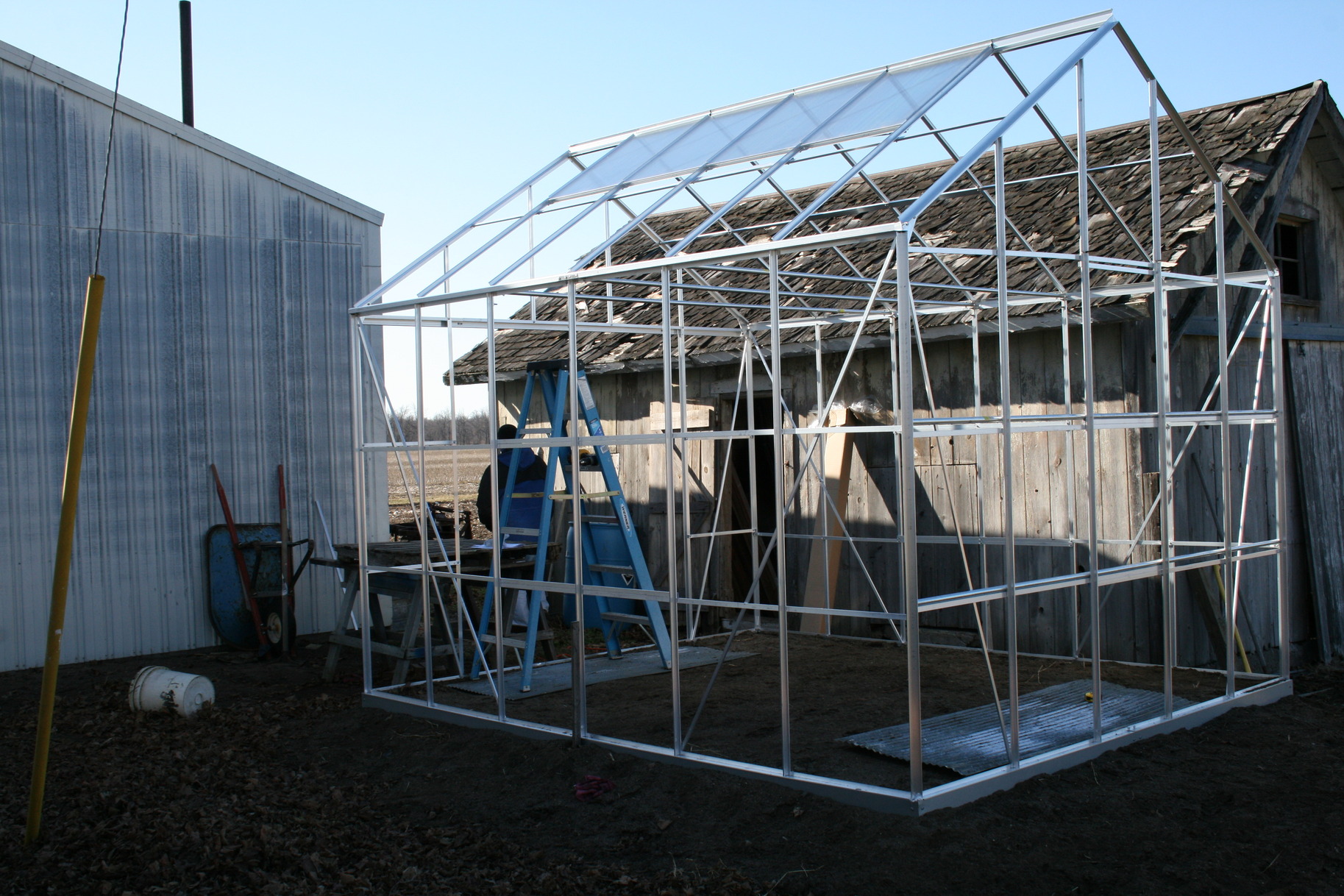
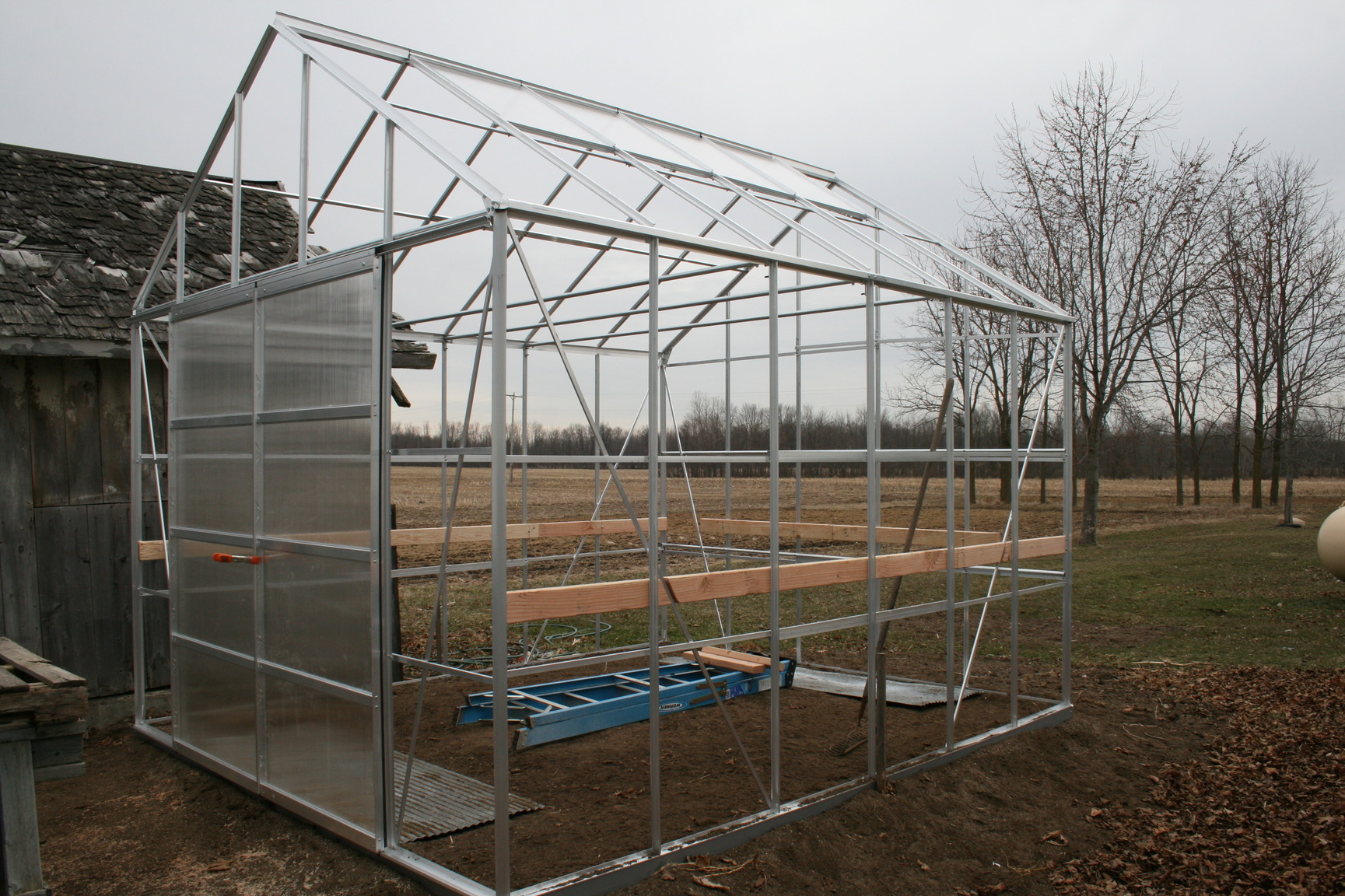
Hopefully I can have significant progress and a fairly complete structure by the end of the weekend. I always seem to get a chuckle from those who state they hope to have this monstrosity completed in a day or two. Especially if working by themselves.

